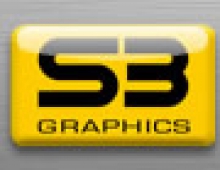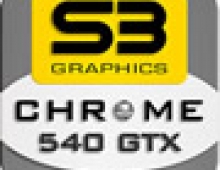
S3 Graphics Launched the Chrome 5400E Embedded Graphics Processor
S3 Graphics on Monday launched the Chrome 5400E embedded graphics processor.
The S3 Graphics 5400E GPU features a native OpenCL 1.0 engine. OpenCL is an open, cross-platform standard used to harness the power of a GPUs internal shaders to accelerate parallel computations in applications ranging from scientific, medical, and other high performance computing (HPC) markets. Driver support of Microsoft operating systems includes Windows 7 Aero, Vista Aero, XP, and CE. Linux kernel 2.6.xx with support for RedHat, SuSE, Ubuntu, Fedora Core, Debian, and other Linux distributions are supported by the 5400E drivers.
The 5400E architecture includes dynamically allocated execution units for its Unified Shader 4.1 Geometry, Vertex and Pixel Shaders. DirectX 10.1 compatible Geometry-shaders allow more complex manipulation of primitives, shadows, and material effects for greater High Dynamic Range Rendering (HDR). The programmable shaders of the 5400E provide a rich user experience for Direct3D, OpenGL, OpenCL, and video rendering.
The 5400E processor is designed for Vista Premium implementations and includes support for WDDM1.0, WEI graphics that meets Vista Premium Logo requirement and AES encryption and decryption.
It is also designed for Windows 7 implementations and includes support for WDDM1.1, WEI graphics and gaming acceleration, AES encryption and decryption and ClearType support.
5400E supports DDR2 memory at frequencies up to 500MHz (1.0Gbps data rate) with a maximum size of 512MB. In addition, it also supports: (a) 256/512MB GDDR3 memory up to 850 MHz (1.7Gbps data rate) and (b) 512MB gDDR3 memory up to 800MHz (1.6Gbps data rate). gDDR3 devices operate at 1.50V, which results in reduced power consumption when compared with GDDR3 and DDR2 devices which operate at 1.80V.
Power management technologies include dynamic voltage and frequency scaling and integrated temperature sensor technology. Individual execution units can also be turned-off when idle which allows additional power savings.
The 5400E GPU incorporates an integrated DisplayPort transmitter, two dual-link DVI transmitters, with integrated HDMI (including support for 7.1 HD audio) and HDCP, an integrated dual-channel LVDS transmitter, and legacy support for an analog CRT display.
The ChromotionHD 2.1 programmable video engine of the 5400E is fully compatible with Microsoft DirectX-VA 2.0 media acceleration. The engine has been optimized to provide enhanced Protected Video Playback (PVP) of a wide range of video codecs, including Windows Media VideoTM 9 HD (WMV9-HD), MPEG-2 HD, VC-1, and H.264 (MPEG-4 AVC). High definition optimized playback from Blu-ray disc is possible with lower CPU utilization. PVP support for HD Premium content includes PVP-UAB (User-Accessible Bus) and display output protection.
The S3 Graphics 5400E GPU features native support of OpenCL, DirectX 10.1 / OpenGL 3.1 graphics engine, ChromotionHD video core for HD video decode (including Blu-ray, H.264, and VC-1), a video encode engine, and OpenVG 1.1 engine. DirectX 10.1 and OpenGL 3.1 applications on Microsoft Windows and Linux platforms can be effectively run using the Chrome 5400E programmable shader cores to speed up 3D simulations, 3D rendering applications, and other visual processing functions. OpenVG 1.1 support boosts 2D based vector graphics for scalable graphics and video vector based applications.
The 5400E architecture includes dynamically allocated execution units for its Unified Shader 4.1 Geometry, Vertex and Pixel Shaders. DirectX 10.1 compatible Geometry-shaders allow more complex manipulation of primitives, shadows, and material effects for greater High Dynamic Range Rendering (HDR). The programmable shaders of the 5400E provide a rich user experience for Direct3D, OpenGL, OpenCL, and video rendering.
The 5400E processor is designed for Vista Premium implementations and includes support for WDDM1.0, WEI graphics that meets Vista Premium Logo requirement and AES encryption and decryption.
It is also designed for Windows 7 implementations and includes support for WDDM1.1, WEI graphics and gaming acceleration, AES encryption and decryption and ClearType support.
5400E supports DDR2 memory at frequencies up to 500MHz (1.0Gbps data rate) with a maximum size of 512MB. In addition, it also supports: (a) 256/512MB GDDR3 memory up to 850 MHz (1.7Gbps data rate) and (b) 512MB gDDR3 memory up to 800MHz (1.6Gbps data rate). gDDR3 devices operate at 1.50V, which results in reduced power consumption when compared with GDDR3 and DDR2 devices which operate at 1.80V.
Power management technologies include dynamic voltage and frequency scaling and integrated temperature sensor technology. Individual execution units can also be turned-off when idle which allows additional power savings.
The 5400E GPU incorporates an integrated DisplayPort transmitter, two dual-link DVI transmitters, with integrated HDMI (including support for 7.1 HD audio) and HDCP, an integrated dual-channel LVDS transmitter, and legacy support for an analog CRT display.
The ChromotionHD 2.1 programmable video engine of the 5400E is fully compatible with Microsoft DirectX-VA 2.0 media acceleration. The engine has been optimized to provide enhanced Protected Video Playback (PVP) of a wide range of video codecs, including Windows Media VideoTM 9 HD (WMV9-HD), MPEG-2 HD, VC-1, and H.264 (MPEG-4 AVC). High definition optimized playback from Blu-ray disc is possible with lower CPU utilization. PVP support for HD Premium content includes PVP-UAB (User-Accessible Bus) and display output protection.
The S3 Graphics 5400E GPU features native support of OpenCL, DirectX 10.1 / OpenGL 3.1 graphics engine, ChromotionHD video core for HD video decode (including Blu-ray, H.264, and VC-1), a video encode engine, and OpenVG 1.1 engine. DirectX 10.1 and OpenGL 3.1 applications on Microsoft Windows and Linux platforms can be effectively run using the Chrome 5400E programmable shader cores to speed up 3D simulations, 3D rendering applications, and other visual processing functions. OpenVG 1.1 support boosts 2D based vector graphics for scalable graphics and video vector based applications.




















